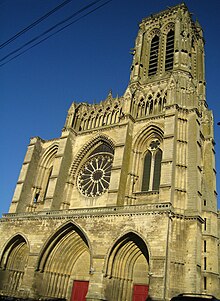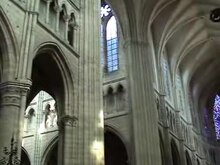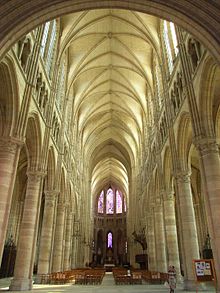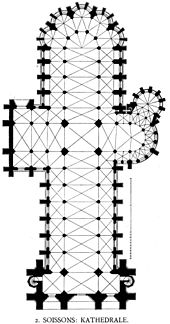Soissons Cathedral
The Saint-Gervais-et-Saint-Protais cathedral in Soissons in the French department of Aisne ( Hauts-de-France ) is the seat of the Bishop of Soissons and has been a minor basilica since 1857 . She is the saint. Consecrated to Gervasius and Protasius .
The church, built from 1180 onwards, is Gothic . Its facade dates from around 1400, the completion of the north tower was prevented by the Hundred Years War . The wheel window in the middle was used much later. The plastic decoration of the portal zones was destroyed in the Huguenot Wars as early as 1567 . Later, the First World War in particular caused severe damage. On the night of 12./13. January 2017 the rose window of the west facade was dented in the hurricane "Egon" and devastated the organ behind it.
facade
In the design of the facade, Soissons imitated the Parisian example of Notre-Dame - with the continuous horizontal floor plan and the little emphasized central zone. The view of the choir from the outside shows how fundamentally and quickly the Parisian invention of the buttress had an impact on French architecture. Here in Soissons, the buttress was included in the planning from the start, as the windows of the central nave would otherwise not have become so high.
inner space
The interior is much better preserved than the facade. The rose window on the west facade also loses its makeshift impression from the inside. The modern organ in Soissons has been matched to the tracery. The glass inside the tracery is new.
The nave belongs to a later phase of Gothic development. It was built shortly after 1190 and has a three-zone wall elevation like at the beginning of the Gothic period, but in completely different proportions. The arcade floor is pulled up a lot and the windows are significantly enlarged. In between there is a four-part triforium . Here a complete balance has been achieved between the arcades and the high nave windows. Both have the same dimensions. Nowhere in the entire history of architecture had there been windows of this size.
The windows of the upper storey are directly in front of the step to the tracery. There are still three separate window units, even if the rest of the wall between them has become very thin. But to be called tracery, these three parts have to come together to form a unit, which will only happen a few years later in 1215/20 in Reims . The vault is already four-part, but not for the first time, but based on the model in Chartres .
Transepts
The oldest part of Soissons is this southern transept from 1180. It has a round end and the traditional four-part wall structure, that of the nave was already three-part. This transept with its very narrow and light column position is described in the specialist literature as one of the most beautiful of the early Gothic.
The ability of the Gothic master builders to create aesthetic structures in the sense of the ordo idea of brilliant beauty from the once more technical possibilities of the ribbed vault and the pointed arch are already very well developed here on the threshold of high Gothic.
The north transept of Soissons is on a completely different level. It was built at the beginning of the 14th century and still has the original Rayonnant windows, i.e. a radial version between 1270 and 1380.
Furnishing
In the end of the choir of the cathedral is stained glass from the 13th century. There are also tapestries from the 15th century depicting the life of the cathedral's patrons, the martyrs Gervasius and Protasius. Furthermore, an Adoration of the Shepherds by Rubens hangs in the north transept, as well as a picture by Philippe de Champaignes .
organ
The organ , which was destroyed in the First World War in 1918 , goes back to an instrument made in 1619 by the French organ builder Crépin Carlier. This instrument was rebuilt in 1690 by Robert Clicquot and restored for the first time by Thierry in 1725. François-Henri Clicquot restored the organ again in 1766, using pipes from an instrument from the Saint-Jean-des-Vignes monastery . Repairs were made by John Abbey in 1803 and by N. Somer in 1830. The damage caused by German artillery fire was repaired by Claude-Ignace Callinet in 1870 . Joseph Merklin built a new plant between 1870 and 1892, using most of the pipes from the Crépin-Carlier organ.
In 1949 Victor Gonzalez was commissioned with the new building. The organ was completed in 1956, it was Gonzales' last instrument. The organ has 67 registers on three manuals (extended manual range - c 4 ) and pedal . The game actions are mechanical and equipped with barker machines. The stop actions are electric. The disposition of the pedal is partly made up of extensions. The instrument has a free pipe prospectus.
In the mid-1980s, the technical problems with the register action increased. Gonzales advised a full restoration, but ultimately only repairs and cleaning were done.
In January 2017 the organ was badly damaged when the rose window immediately above it was dented by the hurricane "Egon" and the debris fell into the instrument.
|
|
|
|
||||||||||||||||||||||||||||||||||||||||||||||||||||||||||||||||||||||||||||||||||||||||||||||||||||||||||||||||||||||||||||||||||||||||||
- Coupling: I / II, III / II, III / I, I / P, II / P, III / P
See also
Web links
Individual evidence
- ↑ Jennifer Alberts, france info: La cathédrale de Soissons endommagée par la tempête. Retrieved January 14, 2017 .
- ^ Kurmann, Peter: Cathedral architecture in France. From the monumental high Gothic to the precious style rayonnant. In: Kunsthistorische Arbeitsblätter 11/00, p. 6
- ↑ musiqueorguequebec.ca: Cathédrale Saints-Gervais-et-Protais. Retrieved January 14, 2017 .
Coordinates: 49 ° 22 ′ 50.9 " N , 3 ° 19 ′ 30.7" E





